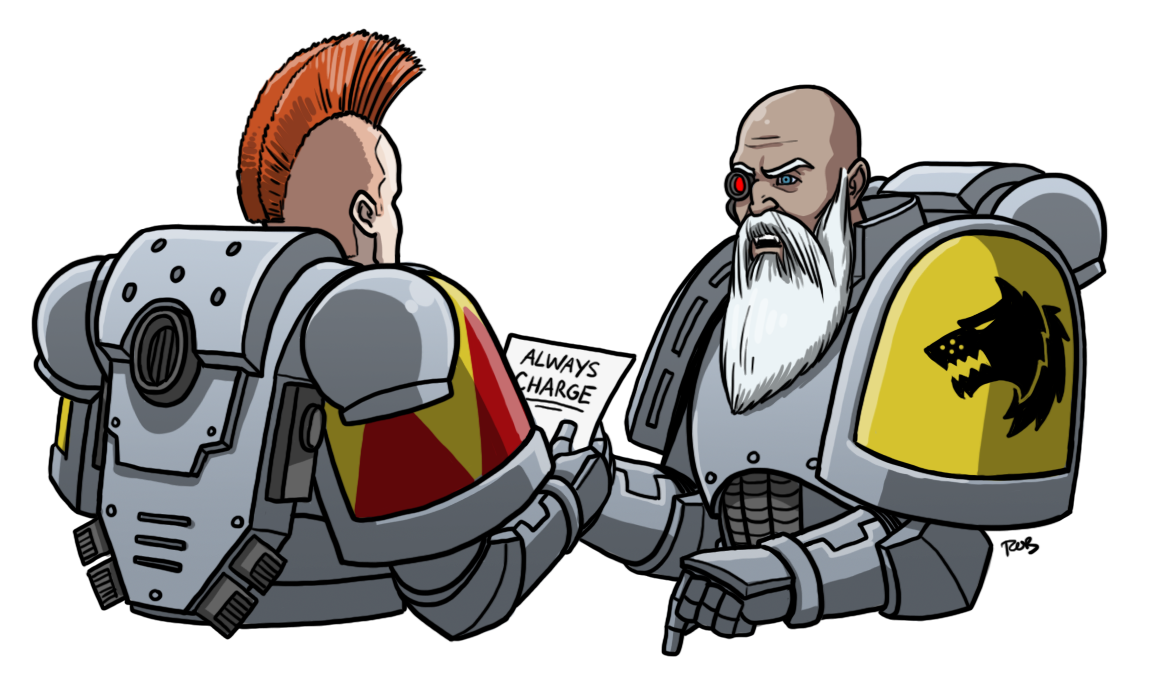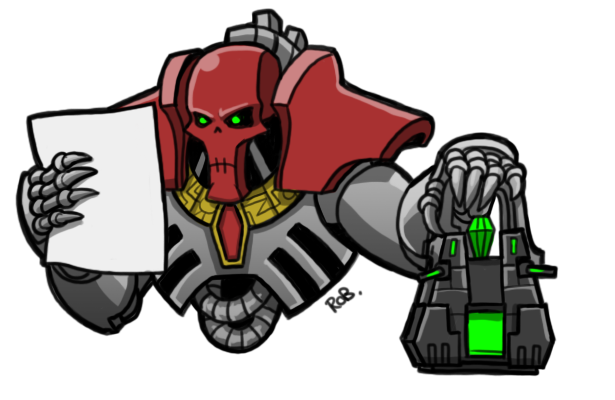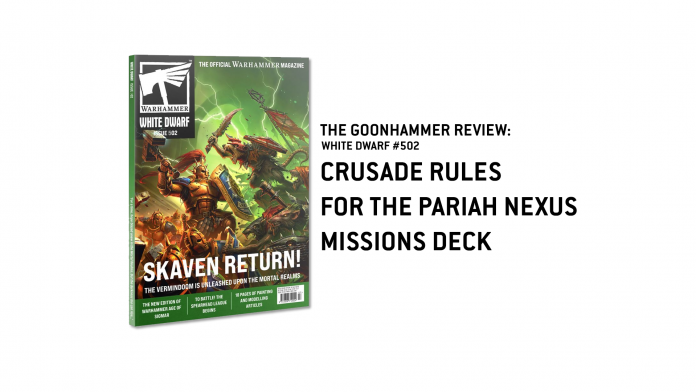One of the more frustrating aspects of the Crusade game mode since its inception in 9th edition has been the way in which its rules don’t align with the game’s competitive rules. And while it’s relatively easy to incorporate things like Errata and the Balance Dataslates, Missions have always been an area of friction for the game mode. Specifically, Crusade missions have typically been completely different from competitive missions, using Agendas instead of Secondary missions as a way of having players generate XP during the mission. This has, at best, been a double-edged sword: The upside is that it gives players goals which may have nothing to do with winning the game, but the downside is that it comes at the cost of removing one of the most important balancing and exciting play mechanisms from the game’s missions. The result is that while matched play missions are more fun and exciting than ever, Crusade missions tend to be relatively boring, or in some cases actively unplayable if you didn’t bring a particular type of army or unit.
All of this is a very long-winded way of saying that I was pretty excited to open up White Dwarf #502 and see that the issue included published rules for playing Pariah Nexus Crusade games using the Chapter Approved mission pack.
What is It?
The short version is that these rules basically give you a framework for playing Crusade missions using the Pariah Nexus missions deck, adding XP rewards for each secondary mission, plus some pre-set mission rule/primary objective/deployment map combinations.
There are six key parts to this rules update, which we’ll cover in greater detail below:
- A New Mission Sequence, detailing the pre- and post-game sequence for games and notes on how to use things like Secret Missions.
- New Crusade Blessings for use in these missions.
- Pre-Prepared Missions, a list of twelve missions, i.e. combinations of primary mission, deployment map, and mission rule, to use in Crusade games.
- Rules for Gaining XP from Secondary Missions. There are no Agendas at play here, so instead every secondary mission in the deck can earn you XP.
- Three new Artificer Relics.
- New Victor Bonuses based on the VP differential at the end of the game.

The Mission Sequence
The Mission Sequence here will be pretty familiar to players who have played matched play games with the Pariah Nexus Missions pack, but may have some new things for Crusade-only players. There’s no Strategic Footing in these missions, so that step from Pariah Nexus is out, but there are still steps for buying pre-game Requisitions and generating Crusade Blessings.
After this you’ll Determine the Attacker/Defender, declare your battle formations – and this sequence adds the standard “no more than half your army can be in Reserves” restriction, along with the rule that units held in reserves past battle round 3 are destroyed. This new mission sequence also puts redeploy rules before the First Turn occurs, similar to competitive play. And similar to comp play, you’ll score 10 VP for having your army painted to a battle-ready standard while primary VP cap at 50 and secondary VP cap at 40.
If there’s something missing here, it’s the rules for performing Actions, but those are available in the mission rules for Pariah Nexus, so you can just use those.
Crusade Blessings
There are six new potential Crusade Blessings to choose from in this new mission pack, and you can have up to four of them depending on the difference in Crusade Points between your two armies. You can’t choose the same blessing more than once. Your options here are:
- +2 starting CP
- In the first battle round, your BATTLELINE units gain the Stealth ability
- BATTLELINE units from your army can shoot and charge after Falling Back
- Once per battle, in your Command phase, you can discard any number of Secondary Mission cards in your hand and draw new ones
- At the start of the battle you can pick one objective in No Man’s Land. While you target a unit within range of that marker with ranged weapons those weapons gain the [IGNORES COVER] ability.
- Pick up to three units from your army to gain the Scouts 6″ ability
These are all pretty solid, and pretty much every one has use to some army or another. You can’t combine them with other Crusade Blessings from different books but most of those involve Agendas or add-on mechanics like Blackstone Fragments anyways.

Pre-Prepared Missions
Similar to the Tournament Companion, the rules in White Dwarf #502 give you a selection of pre-set missions to choose from. There are twelve of these, split into Alpha and Omega missions so you can randomly generate them using only D6s but if you have a D12 you can ignore all of that nonsense. There are two for each Deployment Map, and each Primary Mission is used once, save Burden of Trust which shows up Twice. Every single Mission Rule also gets used here, with Prepared Positions being the repeat.
For the most part, these are pretty solid. I’m not 100% sold on the combinations they’ve used but the good news is that you can consider these as an add-on to the Tournament Mission Pool rather than a replacement – there is absolutely nothing stopping you from using these rules with the mission pool in the Tournament Pack, and having a larger pool is better. Though it’s worth noting that several of these are already in the tournament pack.
That said, these missions don’t come with recommended terrain layouts, so let me suggest the following:
Alpha Missions
- Dawn of War / Take and Hold / Smoke and Mirrors – Layouts 2,3,5
- Search and Destroy / Burden of Trust / Prepared Positions – Layouts 1,2,3,4,6
- Hammer and Anvil / Purge the Foe / Raise Banners – Layouts 1,7,8
- Tipping Point / Terraform / Rapid Escalation – Layouts 1,2,4,6,7,8
- Crucible of Battle / Unexploded Ordnance / Stalwarts – Layouts 1,2,4,6,8
- Sweeping Engagement / Supply Drop / Fog of War – Layouts 3,5
Omega Missions
- Search and Destroy / The Ritual / Inspired Leadership – Layouts 1,2,3,4,6
- Tipping Point / Linchpin / Adapt or Die – Layouts 1,2,4,6,7,8
- Sweeping Engagement / Burden of Trust / Rapid Escalation – Layouts 3,5
- Hammer and Anvil / Scorched Earth / Swift Action – Layouts 1,7,8
- Dawn of War / Unexploded Ordnance / Fog of War – Layouts 3,5
- Crucible of Battle / The Ritual / Prepared Positions – Layouts 1,2,4,6,8

XP Rules
The big addition with these rules is adding rules for how to score XP for your units when you accomplish secondary objectives. There are too many here to cover all of them but they generally follow the format of “when you score VP from this secondary mission you also score XP,” and usually the XP going to the unit responsible. These don’t always work – Bring it Down for example appears to only award XP to a single unit when it’s very possible that multiple units in your army could score that in a turn – this is something we’ve created some guidance on, below. Other than those two, the rest are very straightforward, usually having you pick a unit or two responsible for gaining XP.
It’s worth noting that these new rules both are likely to give you more XP per game than the standard Agendas and give XP to a wider variety of units – the shifting nature of them means you’re likely to snag more VP with different units in your army for doing different stuff, rather than picking the two agendas you know you can score for the 1-2 units that end up scoring all your non-Marked XP normally.
Recommended Errata:
Based on these errors, we’d suggest the following:
- Bring it Down: Change this to read: “When you score VP from this Secondary Mission, each unit from your army that destroyed a MONSTER or VEHICLE unit that turn gains 1 XP. If that enemy unit had a Wounds Characteristic of 20 or more, gain 2 XP instead.”
- Cull the Horde: Change this to read: “When you score VP from this Secondary Mission, each unit from your army that destroyed a qualifying unit that turn gains 2 XP.”
New Crusade Relics
There are three new Artificer Crusade Relics in these rules. They’re all focused on interactions with the secondary missions deck:
- Rod of Command lets you look at the top card of your mission deck and put it on the bottom before you draw each round.
- Shard of Shattered Futures lets you remove up to three cards from your deck at the start of the first battle round.
- Nameless Tome lets you use the New Orders Stratagem for 0 CP while the bearer is on the battlefield.
These are all dynamite if you’re playing lots of these missions and it’s cool to see things which interact mechanically with the missions deck in a way that can’t really happen with the game’s more formal rules and datasheets.

Victor Bonuses
Victor Bonuses are handled differently in these rules: At the end of the game you can choose a bonus, and your pool increases in size based on the differential in VP between you and the opponent. This is a really cool idea, and the rewards are interesting.
- 0+ VP differential: The Victor’s force gets +1 Requisition Point.
- 15+: The Victor increases their Supply Limit by 300 points.
- 30+: The Victor can pick a CHARACTER unit to gain a Crusade Relic.
- 45+: The unit in the Victor’s Crusade force that was Marked for Greatness gets an extra 10 XP.
Final Thoughts
This is something Crusade has needed for a long time and I’m surprised it took this long for it to happen. These new rules are exactly what playgroups have needed for a while to both increase the amount of variety in their campaigns and also help bridge the gap with more competitive players who otherwise don’t want to play the often lackluster missions in the Tyrannic War and Pariah Nexus Crusade Books. I think the White Dwarf crew have done a stellar job with these new mission rules and I’d recommend that anyone playing Crusade or running a Crusade campaign go out and get their hands on a copy ASAP.
The one thing to watch for with these missions is XP. As I mentioned earlier, you’re likely to score more XP from these missions than most standard Crusade missions with Agendas, and so having them may impact campaign progression in your Crusade league. Also note that these really don’t play well with Agendas, which means they won’t always play well with the custom faction Crusade rules. That said, it’s probably worth revisiting those soon to figure out how to marry the two up.
Have any questions or feedback? Drop us a note in the comments below or email us at contact@goonhammer.com. Want articles like this linked in your inbox every Monday morning? Sign up for our newsletter. And don’t forget that you can support us on Patreon for backer rewards like early video content, Administratum access, an ad-free experience on our website and more.


